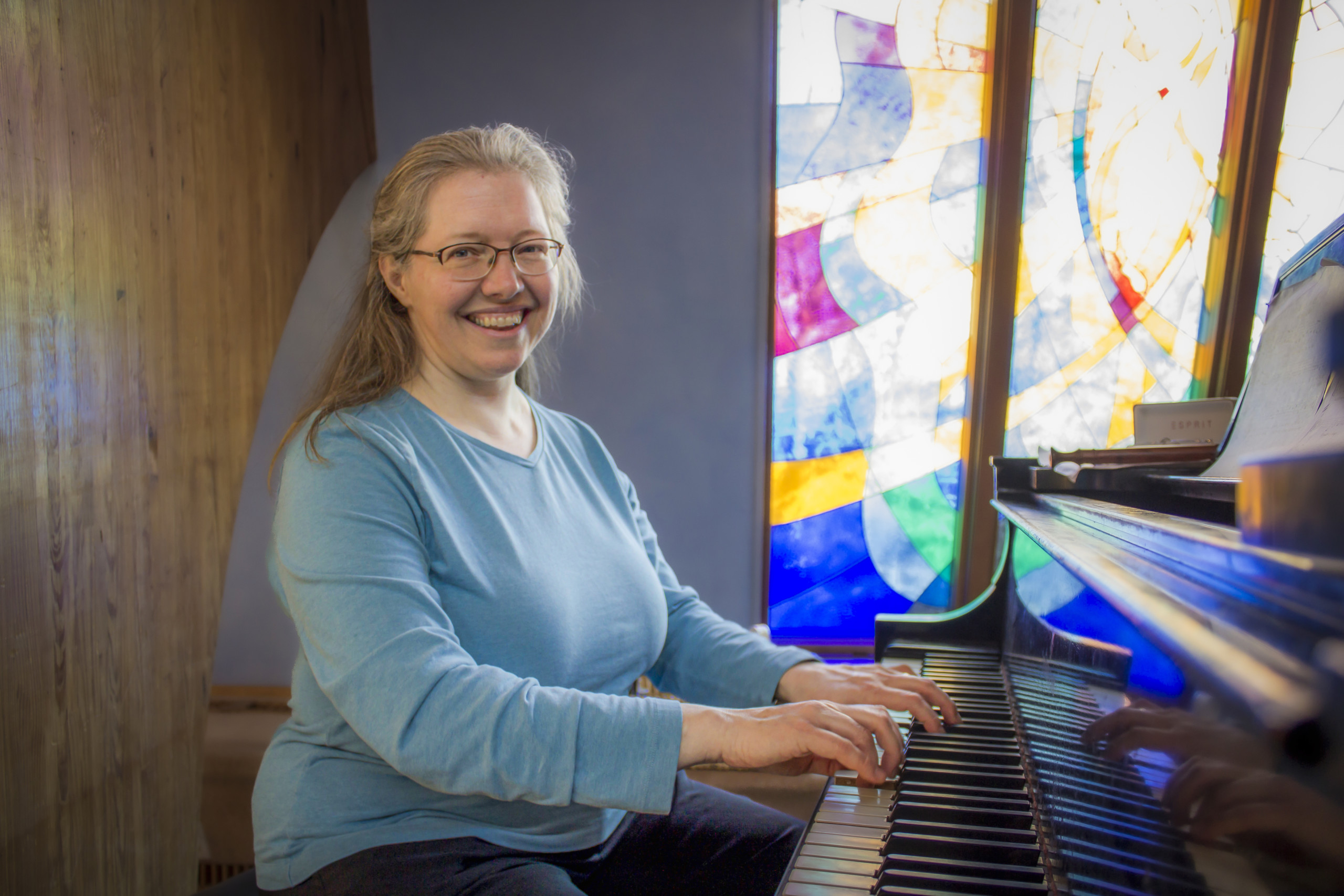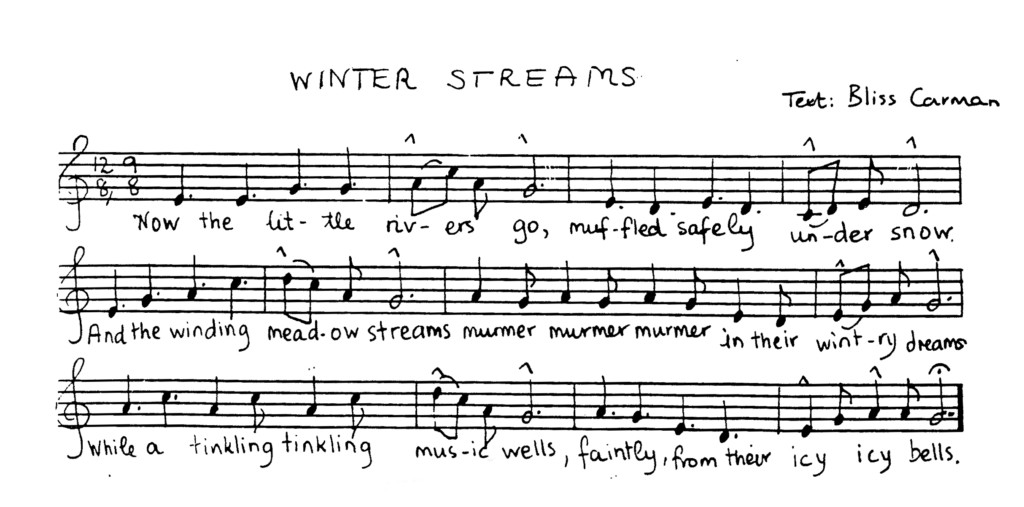Thoughts on the Music Curriculum at The Camphill School

“Music builds a bridge, it can tear down a wall.
Music is a language that can speak to one and all.”
From “Why We Sing” by Greg Gilpin, a favorite for our High School Choir to perform
At The Camphill School, music accompanies our journey through the changing seasons and its many moods. Music awakens and nurtures the inner child. For all of our students, music is a means of expression, a universal language of the soul. The capacity for social connection through shared music cannot be understated. In selecting music for each class, the question to answer is, “What will engage the students where they are developmentally?” Teaching music is an art requiring flexibility in the moment to gauge the mood the class needs from the music.

Simple melodies with a gentle voice and gestures to accompany the songs help kindergarteners integrate the music. I play a choroi flute and lyre and sometimes children play a jingle stick. While singing Julius Knierim’s “A Lovely Rainbow,” we float a colorful scarf. The current favorite is “So Fast, So Fast My Horse Does Go.” The song begins galloping, as you might imagine, gradually settles into a trot, and finally a stop, with a “Neigh!” after the silence.
While the choroi flute and lyre are still used, first graders play interval flutes and sing melodies with accompanying gestures. We also add streaming children’s lyres and a glockenspiel, especially for children whose challenges may keep flute playing out of reach. We have varying three-toned glockenspiels that together sound the pentatonic scales, the base of many of our songs. Knee bars (a resonant piece of wood with a felted mallet) are wonderful for wood-chopping songs. A perennial favorite is Peter Oram’s “One for the Golden Sun.”
In second grade, melodies shift to the pentatonic modes with gestures remaining a primary means of musical integration. Children imitate simple patterns derived from our song on their lyres. Students enjoy the circle dance “Old Grey Wagon” and “Winter Wind, Blowing at My Window.” Students continue practicing with interval flutes since time and repetition are essential.
Melodies move toward the major mode for third grade and we introduce notation with the ascending major scale. Students prepare to cross the threshold with their canoe song, “My Paddle’s Keen and Bright.” We explore the C Major Scale with flutes, chimes, bells, the piano, and Christof-Andreas Lindenberg’s “Let’s Build a House.” “Little Red Bird” offers a minor mode contrast and is a wonderful ‘feeling’ tune from the Celtic Isles. Call and response songs and ostinatos (a short repeated phrase) begin the path towards harmony. Children add simple accompaniments with a bordun lyre, chimes, alto tone bars, and ma drum.
Fourth graders experience the world in separate pieces and our music is broken into pieces, too, through harmony and rhythmic division. Triads provide a soothing experience, with Bordun lyres, bells, and hand chimes to accompany our songs with full harmony. We explore rhythmic patterns with a clear beat as drums and tone bars take the stage. Major and minor songs fill the repertoire. The class separates into teams, learning the rhythm of taking turns listening and responding. The class sings rounds, a favorite being “One bright and sunny morning, I walked the forest through, and suddenly I heard a soft and low cuckoo.”
Meeting melody, rhythm, and beat enhances physical development in the fifth grade. Children are more conscious of discord and harmony and want adventure and exploration in music. American folk music, gospels, and spirituals allow for many accompaniments that provide harmony. Movement, especially folk dancing, assists in feeling musical phrases in the limbs. Some favorites from fifth grade include the Scottish round “Deep Peace” and folk songs like “Rocky Mountain High” and “We’re Floating down the River.”
“The tone or melody or any kind of harmony is really experienced by the whole human being,” says Rudolf Steiner. Sixth graders want to understand the physics of music as they awaken to harmony and beat. We sing rounds, partner songs, and three-part harmonies. Students feel the richness of music physically and emotionally with ballads and bowing strings of the cello. Bell and Bordun lyre accompaniments reflect richer harmonies. Sixth grade explores the music of medieval history. This is the year of the minstrels and students relish in solos on xylophones and glockenspiels. The American folk song “How Can I Keep from Singing” with lyre accompaniment from the entire class is a favorite, as is the two-part harmony and gesture of “It’s Day! The Sun with Morning Light Wakes Every Living Thing.”
Personality pervades the joyful engagement with music making in seventh grade. Unison melodies allow for the changing voices of boys and sea chanteys capture the exploration energy as we sample music of different cultures. We introduce Renaissance music and music history. A favorite tune is “Greensleeves:” Lorre Wyatt’s “Somos el Barco” is an enduring seventh grade song at Beaver Run, requested for its soothing qualities. The chorus, sung in Spanish and English, speaks of our interconnectedness: “I sail in you, you sail in me.”
Eight grade has a new maturity to bring to their experience of music. Music is a bridge from the individual to what we encounter outside the self. We continue to explore world music and ballads, searching for self-expressive motifs. Classroom instrumental ensembles take on more complexity and there is social satisfaction in how this comes together for the entire group. Drumming is a real joy and the contra bass bars match the depth of feeling for the students. At the end of each music session, a few moments of silence serve to integrate the spirit released. Part of the year is devoted to preparing music for the Eighth Grade Play.
High School Choir is an important social time, where a feeling of belonging and whole-hearted musical expression deepens the soul experience. There is a contagious joy felt when we perform during assemblies. A mix of singing, instrumentals, dancing, and American Sign Language may be part of our offering. Repertoire may include a deeply felt American folk ballad like “Shenandoah” or an exuberant arrangement of “Funga Alafia,” a Nigerian welcome song. Music to match the mood of the season is always included.
For ninth graders, new freedom and the accompanying creative chaos can be daunting with music as both solace and seed for growth. Their music block explores Baroque Era composers. This was a time composers borrowed from each other across borders and cultures, a time of spontaneity, improvisatory ornamentation, strong bass lines, and a perpetual motion driving forwards. Students play snippets of Vivaldi’s Four Seasons with a variety of accessible instruments. The Prelude from Bach’s well-tempered Clavier, with the all-important bass line played with bells by students creates a beautiful duet, as I play piano.
Students in tenth grade search for authentic musical experiences and objective understanding as they explore the thematic wrestlings of Classical Era composers. A Haydn theme becomes an orchestra invitation with altered lyrics: “Come and hear the tenth grade orchestra.” Students take turns directing the class (and teacher!) with a conductor’s baton, choosing tempo and dynamics. Mozart’s “A Little Night Music” is played by a bell ensemble and the second theme played by lyres, bass, and contra bass bars. With Mozart’s “Rondo alla turca” and Beethoven’s “Fur Elise” students play lyres, tone bars and recorders, between listening to my rendition of the contrasting sections on piano. We also have Opera Day, when we sing everything, including casual conversation, and explore Mozart’s “Magic Flute.”
Eleventh graders are developing individual musical tastes and deepening their friendships with each other. We explore the Romantic Era composers, who wrote and performed music out of their personal soul life and together with friends. Favorites include Schumann’s “Happy Farmer” experienced as a song and dance, Schubert’s “To Wander Is the Miller’s Joy” accompanied by lyres, Brahms’ Symphony No. 1, set with my lyrics: “We are the eleventh grade, the most awesome grade of all,” and “Lullaby” with students taking turns playing a soothing cello or chrotta. This is a great year for listening, responding with observations, descriptive words, and personal emotions to Schubert’s “Ave Maria,” a Brahm’s Intermezzo, or a Chopin Waltz.
Twelfth grade is a time to explore present-day music. Throughout history, music acts as a mirror for humanity. Some favorites from the last few years include “What a Wonderful World,” Georgia Sea Island spiritual “Yonder Come Day,” and Paul Desmond’s “Take Five.” Inner upheaval and transformation is part of twelfth grade. The question, “Who are you?” is explored through music. This is a great year for improvisation with a favorite being “Heart and Soul” sung with observations highlighting individual students. The senior play occupies the bulk of the music block for this year, with chorus, duet, and solo preparations. What a joy to perform!